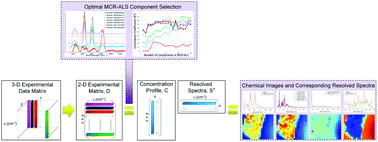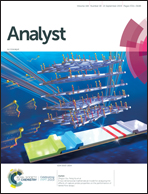A novel multivariate curve resolution-alternating least squares (MCR-ALS) methodology for application in hyperspectral Raman imaging analysis†
Abstract
Multivariate curve resolution-alternating least squares (MCR-ALS) applied to hyperspectral Raman imaging is extensively used to spatially and spectrally resolve the individual, pure chemical species within complex, heterogeneous samples. A critical aspect of performing MCR-ALS with hyperspectral Raman imaging is the selection of the number of chemical components within the experimental data. Several methods have previously been proposed to determine the number of chemical components, but it remains a challenging task that if done incorrectly, can lead to the loss of chemical information. In this work, we show that the choice of ‘optimal’ number of factors in the MCR-ALS model may vary depending on the relative contribution of the targeted species to the overall spectral intensity. In a data set consisting of 27 hyperspectral Raman images of TiO2 polymorphs, it was observed that the more dominant species were best resolved with a parsimonious model. However, species with intensities near the noise level often needed more factors to be resolved than was predicted by standard methods. Based on the observations in this data set, we propose a new method that employs approximate reference spectra for determining optimal model complexity for identifying minor constituents with MCR-ALS.



 Please wait while we load your content...
Please wait while we load your content...
